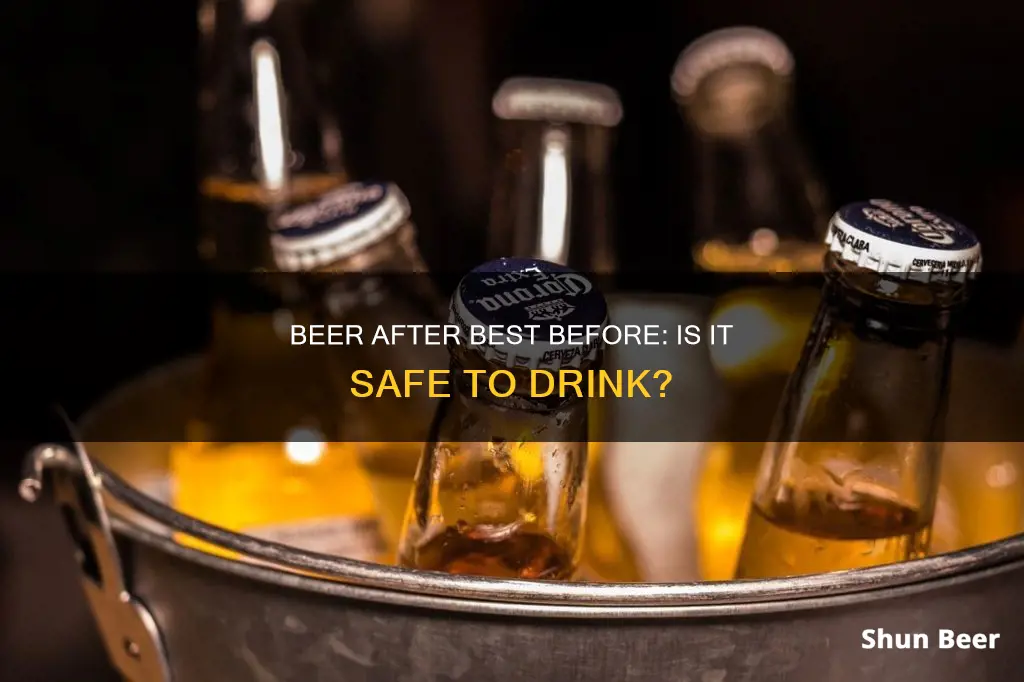
Beer typically has a best before date, which is different from a use by date. While the former is a guideline on quality, the latter is a rule on food safety. This means that beer can be safely consumed past its best before date, although its quality will start to deteriorate. At room temperature, beer lasts about 5 to 9 months beyond its best before date, while refrigeration can extend its shelf life by up to 2 to 3 years. However, opened beer has a much shorter shelf life of about a day, regardless of whether it is stored at room temperature or in a refrigerator.
| Characteristics | Values |
|---|---|
| Is it safe to drink beer past its best-before date? | Yes, but it may not taste as good. |
| How long does beer last past its best-before date? | At room temperature, beer lasts about 5 to 9 months beyond the best-before date. In a refrigerator, beer can last up to an additional two or three years. |
| What factors affect how long beer lasts? | Beer type, packaging, and storage conditions (e.g., temperature, light exposure) |
| How can you tell if beer has gone bad? | Bad aroma, lack of "pssst" sound and foaming when opened, excessive sediment at the bottom of the bottle |
What You'll Learn

Beer's 'best before' date is a guideline on quality, not safety
Beer typically has a 'best before' date, which is different from a 'use by' date. While the latter is a rule regarding food safety, 'best before' is a guideline on quality rather than safety. This means that beer will start to lose its quality after the stated date, but it can still be consumed.
Beer is produced with expiry dates, but these are not hard-and-fast rules. Beer doesn't expire in the same way that fresh food does, and it is generally safe to drink even after its "best before" date. This is because the alcohol content in beer, along with the presence of hops, prevents pathogenic bacterial growth that can cause humans to get sick. The hops in beer have antimicrobial characteristics, so there is little to no pathogen growth.
The main issue with drinking beer past its "best before" date is a potential decline in quality and taste. Beer can go flat and develop unpleasant flavours and aromas over time, especially if it is exposed to sunlight or temperature fluctuations. However, this is not always the case, as some beers can actually improve with age. Richer and higher ABV varieties, such as porters and stouts, can get better with age if stored in cool, dark conditions. On the other hand, IPAs are best consumed fresh, as they gradually lose their flavour and aroma.
To prolong the life of your beer, it is recommended to store it in a cool, dark place, such as a refrigerator, basement, or cellar. Beer can last up to two to three years past its expiration date when refrigerated, but only four to nine months at room temperature.
Beer and Lorazepam: A Recipe for Nausea?
You may want to see also

Beer can be drunk years after its 'best before' date
Beer can be drunk years after its best-before date. While beers do have expiry dates, these are more of a guideline on quality rather than safety. This means that beer will start to lose its quality after the stated date, but it can still be consumed. The taste may be stale or muted, and the alcohol content may be reduced, but it will be safe to drink.
The shelf life of beer varies depending on the type of beer and how it is stored. Beer stored in a refrigerator can last up to two to three years past its expiration date, while beer stored at room temperature will only last four to nine months. Beer stored in clear or green bottles will have a shorter shelf life due to light exposure, which can cause the beer to develop a skunky odour and taste.
Some beers, such as barley wines and imperial stouts, are brewed with the intention of being aged. These beers can improve with age, especially when stored in cool, dark conditions. However, IPAs are best consumed fresh, as they gradually lose their flavour and aroma over time.
To prolong the life of your beer, it is recommended to store it in a cool, dark place, such as a basement or cellar. Keeping beer in the fridge can also help to maintain its freshness, as can storing it in a designated beer fridge set between 38 and 50 degrees Fahrenheit.
Beer and Blood Work: Is One Drink Okay?
You may want to see also

Beer should be stored in a cool, dark place
Firstly, it is important to note that beer should be stored upright and that temperature fluctuations can impart off flavours to beer. Therefore, it is best to store beer in a cool, dark place, away from temperature fluctuations. A good rule of thumb is to use the 3-30-300 rule, which states that beer can be kept at 90°F for only 3 days before it goes bad, 30 days at 72°F, and 300 days at 38°F.
Secondly, exposure to sunlight can cause the beer to develop a skunky odour and taste. This is due to a chemical reaction triggered by ultraviolet light coming into contact with certain hop compounds. To avoid this, beer should be stored in a dark place and in packaging that keeps light out, such as brown glass bottles, which block almost 100% of UV light.
By following these guidelines and storing beer in a cool, dark place, you can help to prolong its shelf life and maintain its optimal taste and quality.
Beer and Diabetes: One Drink, Many Concerns
You may want to see also

Beer stored at room temperature will last 5-9 months beyond its 'best before' date
Beer is produced with expiry dates, but these are more of a guideline on quality than safety. Beer stored at room temperature will last 5-9 months beyond its best-before date. However, it is important to note that the quality of the beer will start to decline after the best-before date, and it is recommended to drink beer as fresh as possible.
Beer is best preserved when kept cold. Keeping beer at room temperature can reduce its shelf life from nearly six months to only a few weeks, and exposing it to very warm temperatures can affect its flavour in a matter of days. The ideal temperature for storing unopened beer is between 45 and 55 degrees Fahrenheit. Beer can be stored in a refrigerator, where it will remain at its best quality for up to eight months.
It is also important to store beer in a dark place, as exposure to sunlight can cause a chemical reaction in the beer, breaking down its flavour components and resulting in an unpleasant taste and aroma. Additionally, beer should be stored upright to minimise contact with oxygen, which can alter the taste.
While drinking expired beer is unlikely to cause illness, it may result in an unpleasant taste and aroma. The biggest indicator of expired beer is a lack of carbonation and a flat taste. Other signs include a faded or discoloured label, sediment at the bottom of the bottle, and leakage around the bottle opening.
Beer and Prostate Surgery: What You Need to Know
You may want to see also

Opened beer has a shelf life of about a day
Oxidation and sunlight are the two things that will cause your beer to go bad. Direct sunlight can give your beer a skunky smell, according to Sierra Nevada. So, if you're storing beer, it's best to keep it in a cool, dark place, away from temperature fluctuations. Keep it upright to minimise oxidation, and avoid exposing it to direct sunlight. UV rays can make the beer lose its flavour.
If you're storing unopened beer, it's best to keep it in the fridge. When refrigerated, unopened beer can last up to two or three years. However, this will depend on the style of the beer and its ABV. If you don't have space in the fridge, keep it in the coolest part of your house, like a cool basement or cellar.
If you're storing beer at room temperature, it will last about 5 to 9 months beyond the expiration date listed on the label.
Last Night's Beer: Is It Still Good?
You may want to see also
Frequently asked questions
Yes, you can drink beer past its best-before date. The "best before" date is more of a guideline on quality rather than safety. Beer won't make you sick past this date, but it may not taste as good.
Beer stored in a refrigerator can last up to two to three years past its best-before date. If stored at room temperature, it will last four to nine months.
Beer that has gone bad will have a bad aroma. It may also lack the usual "pssst" sound and foaming at the top when opened. Excessive sediment at the bottom of the bottle may also indicate that the beer has gone bad.







